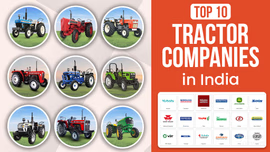Important Tractor Terminologies You Should Know Before Buying a Tractor

While buying a tractor, you should be aware of all the terms and technical jargons associated with it. This understanding will help you make an informed, wise and right decision as per your requirement. So, lets dive into this blog to understand the most important tractor terminologies in easy-to-understand language.
Table of Contents
- Introduction
- Horsepower (HP)
- Engine Capacity
- Revolutions Per Minute (RPM)
- Bore and Stroke
- Torque
- Backup Torque
- Specific Fuel Consumption (SFC)
- Drawbar Power
- PTO Horsepower (PTO HP)
- Conclusion
Introduction
Are you planning to buy a tractor for the first time? Then it will always be overwhelming for you to understand the terms and technical jargons associated with a tractor. You may find the terms such as PTO HP, Torque, Backup Torque, etc., very confusing. Therefore, before visiting your nearest tractor dealer, go through the below information to decode the complicated tractor terminologies.
Horsepower (HP)
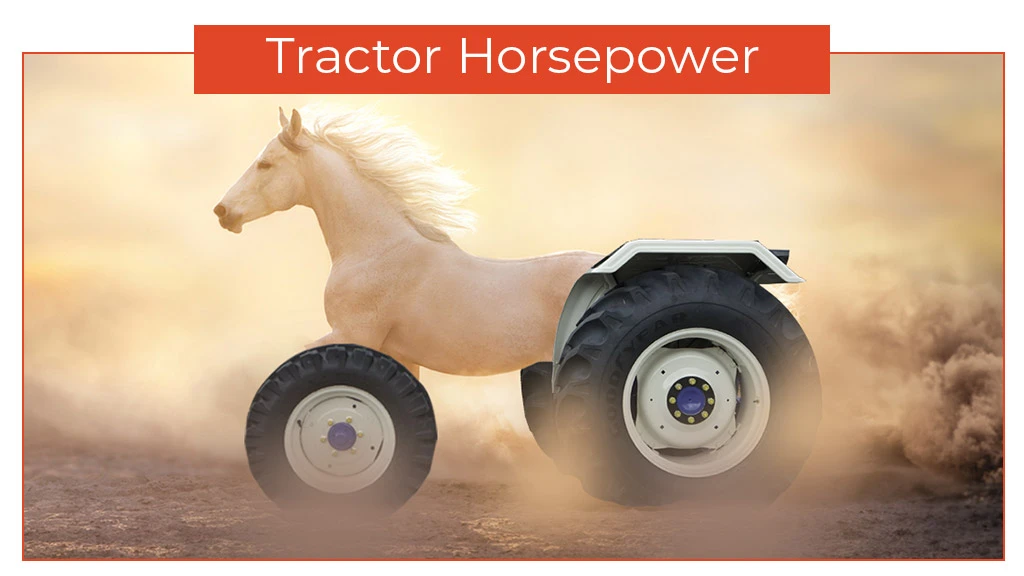
What does HP mean in a tractor and what role it plays in a tractor? For the unversed, a tractor is designed to do heavy-duty work at slow speeds and a farmer generally sees the engine HP of a tractor before buying it.
The HP of a tractor is the maximum power output which a tractor engine produces. It is a measure of engine strength, that is, how much work a tractor engine can do over a period of time. It determines a tractor’s ability to handle challenging tasks or heavier loads. It also determines how quickly a tractor can complete a task.
So, higher the HP, higher will be a tractor’s ability to handle heavier loads and quicker will be the completion of a task.
Engine Capacity
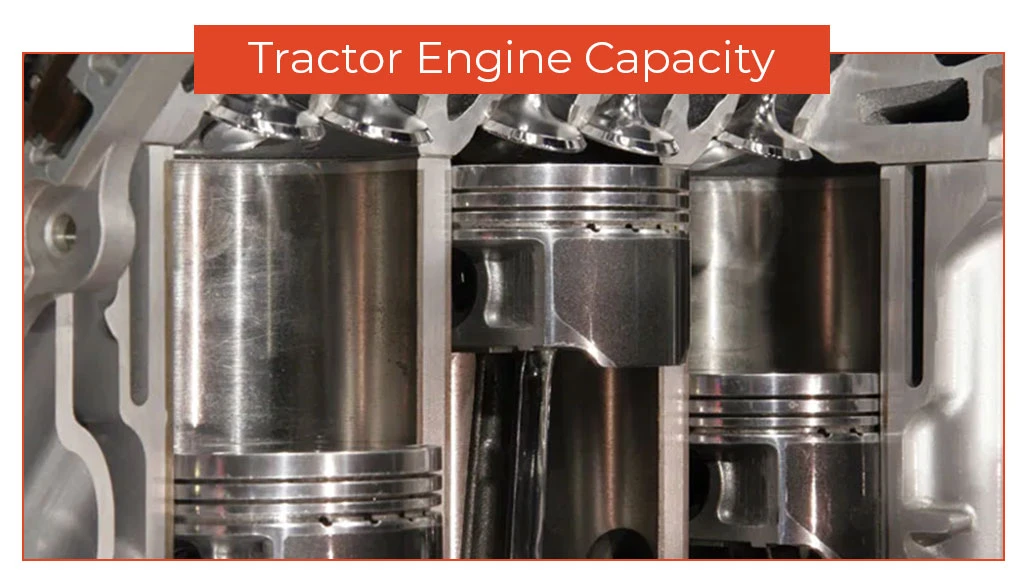
While buying a tractor, you will come across the term engine capacity that this tractor has bigger engine and thus will produce more power. But is it so? So, let us understand the term engine capacity.
A tractor engine works when the mixture of air+fuel pumps through all cylinders. So, the volume of air displaced by an engine to burn fuel to make it work is called engine capacity. It is also called engine displacement. It is measured in Cubic Capacity (CC).
The engine capacity directly measures the size of an engine and its capacity to burn fuel and produce power.
Generally, a larger engine is associated with powerful performance. But it is a misconception. Factors like engine design and advanced fuel injection systems can also enhance overall engine performance.
Revolutions Per Minute (RPM)
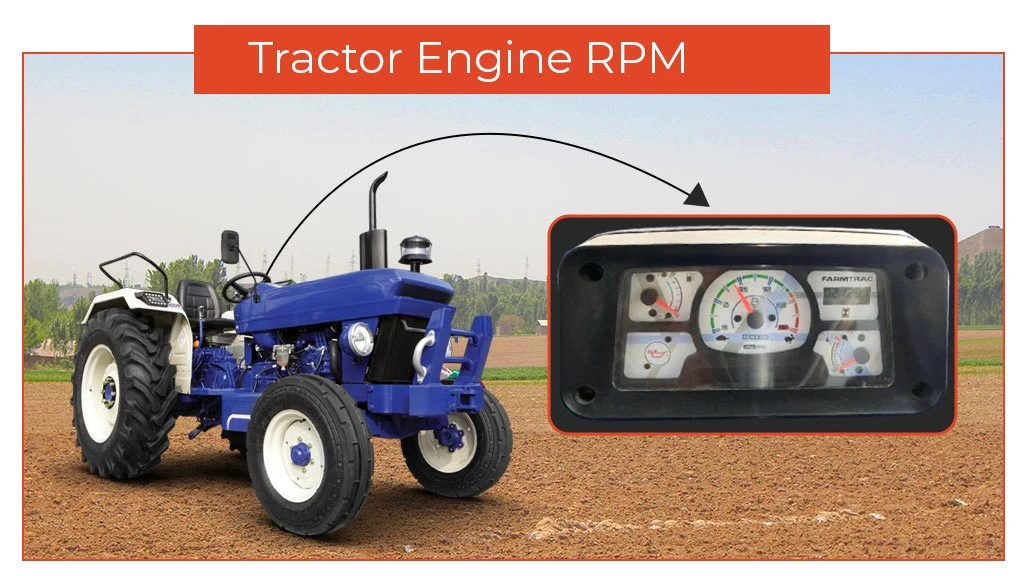
While scanning through brochure of a tractor, which you wish to buy, you might have seen 50 HP @ 2200 RPM or PTO HP of 45 HP @ 1965 RPM. What does RPM stand for and what does it indicate?
RPM stands for Revolution Per Minute, that is, how fast the engine of the crankshaft is moving in a single minute. It indicates how the engine speed in combination with torque influences horsepower. So, you can either increase the RPM or the torque to increase the horsepower.
Also, if a tractor produces more power at lesser RPM, it means the tractor is highly fuel-efficient as is the case with Massey Ferguson tractors.
Bore and Stroke
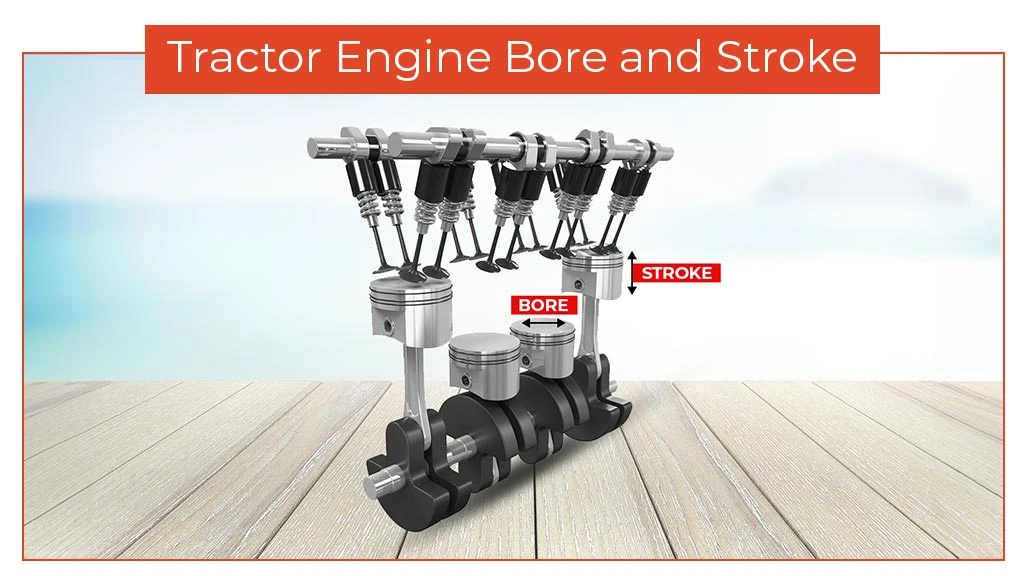
While buying a tractor, you should know the meaning of bore and stroke and how does bore-to-stroke ratio affect the combustion of fuel and generation of power.
The bore of a tractor engine refers to the diameter of a cylinder in which the piston moves. It measures the inner diameter of the cylinder in millimetres (mm). The bore determines the combustion chamber’s size where the air-fuel mixture is ignited.
The stroke refers to the linear distance the piston travels inside the cylinder. It is the measurement from the piston's top dead centre to the bottom dead centre. The distance travelled is called stroke length and is measured in mm. It determines the engine's capacity to move air-fuel mixture within the combustion chamber.
Now, the bore-to-stroke ratio is critical for figuring out how the engine works. It is the ratio of stroke length to bore diameter and the ideal ratio in tractors used to be about 1.25. But it is greatly influenced by the engine design and the use of tractor. For instance, the use of CRDI fuel pumps in tractors has led to higher ideal ratio.
Torque
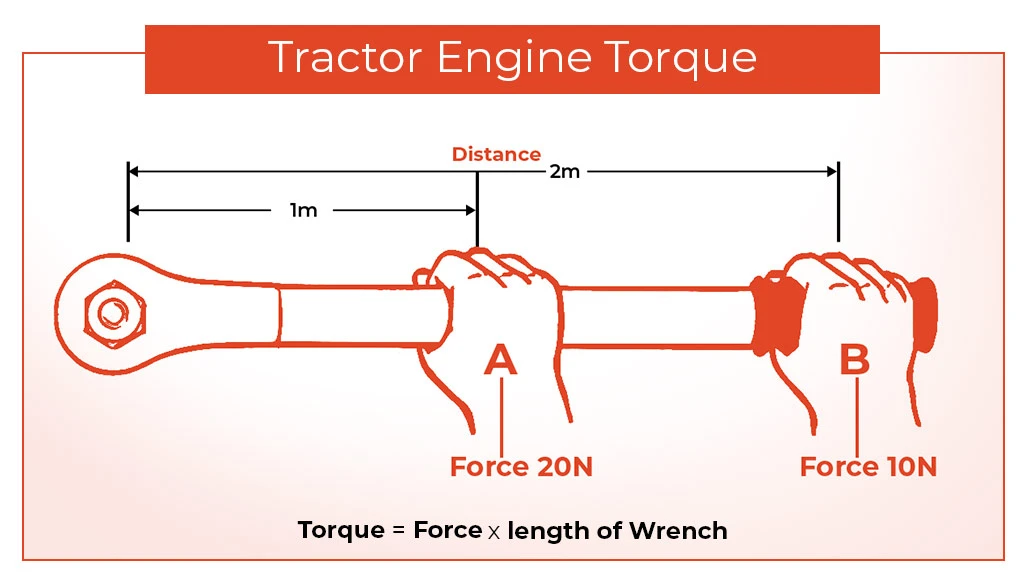
While explaining the meaning of horsepower in above paragraphs, we mentioned that horsepower and torque are directly related. So, what torque is, why it is important at low gear speeds and what is the relation between torque, RPM and HP? Let’s understand.
Torque is a twisting force that causes motion in an object around an axis. It is the force initially required to do the work. It is the product of distance from the centre of the axis (lever length) and the force applied at that distance. It is measured in Newton-meter (Nm).
To understand torque, let’s take the example of torque wrench that is required to tighten or open the nut bolt. In this, opening the bolt by catching the wrench at a distance nearer to the axis, requires more force to be applied but at a distance farther from the axis requires less force to be applied. However, as you can see from the above image, that in both the cases torque remains the same.
Similarly, a tractor initially requires a greater force to start the work. Since, the tractor is required to do heavy-duty work, thus the torque in a tractor is higher compared to that in a car.
Moreover, in a tractor, torque acts on the drive shaft when it rotates and is the most important at low engine speeds as it provides efficient operation with more towing power from a standstill.
Torque, HP and RPM
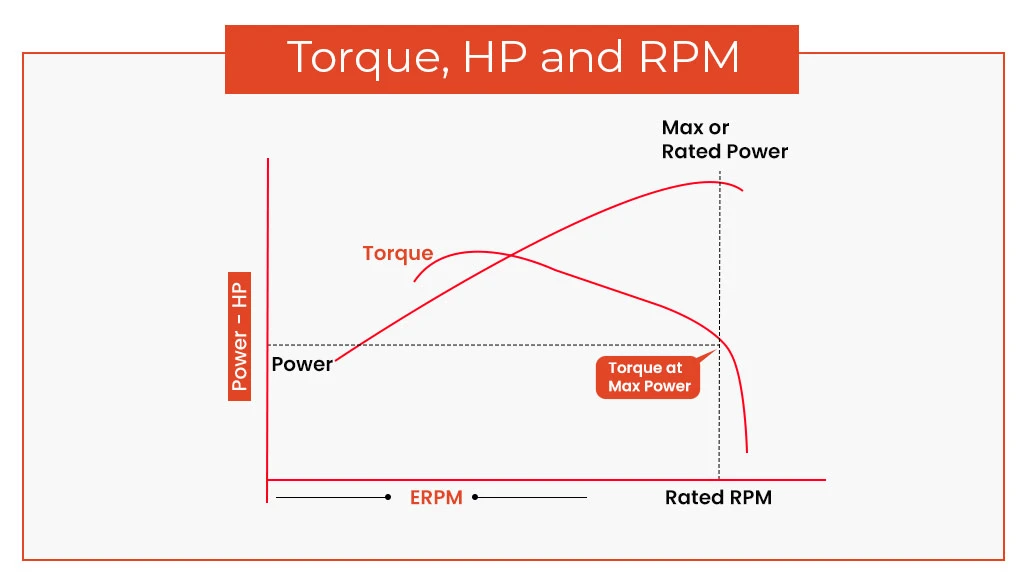
Torque and horsepower are directly related but they are not same. Torque does a work with power, whereas horsepower does a work with speed. In other words, the work which you started with the help of torque, the horsepower enables you to quickly complete that work.
Furthermore, torque, horsepower and RPM are also related with each other. With the increase in RPM, the torque and horsepower increase but up to a point. At higher RPMs, the torque will start decreasing but horsepower will keep increasing, until the fall in torque is greater than the fall in RPM (See above image). This is because engine has to do work harder to maintain the higher RPM.
Now, the question is whether to look at torque or horsepower while buying a tractor. A higher torque is required for puddling, tilling a soil with hard pan or to do work without obstacles but if you have to complete a work with speed on soft soil surface, then HP is required. It is best to maintain a balance between HP and torque while purchasing a tractor.
Backup Torque
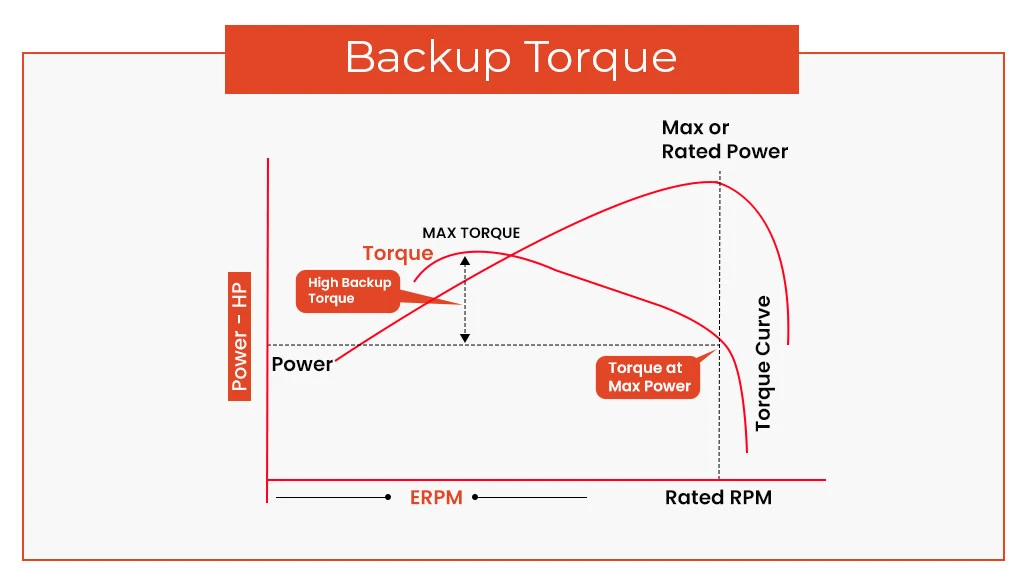
Suppose, you are pulling a fully-loaded trolley and your tractor is operating at maximum torque at low 3rd gear. Due to heavy load, the tractor is dropping RPM, now what will you do? You will either lower down the gear at the cost of speed to provide more power or if the tractor has good backup torque, it will use it without lowering the gear.
So, when you are using more power, then the tractor is operating at peak torque. It is this percentage increase in torque from maximum torque of a tractor to its peak torque is called backup torque.
Therefore, a backup torque is needed when a tractor is doing a heavy work. It allows the tractor to absorb more load without any loss in productivity. A high backup torque in a tractor indicate that tractor is powerful and you will be able to perform heavy-duty farm works without changing gears.
Specific Fuel Consumption (SFC)
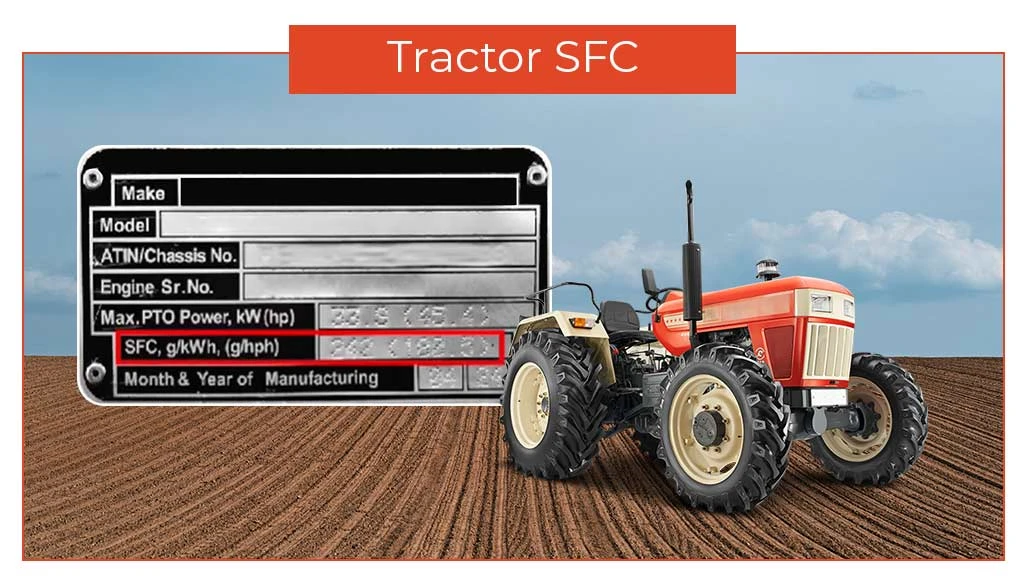
The most important thing after horsepower which you should look for while purchasing a tractor is the fuel efficiency. Farmers in India are especially concerned about how much diesel the tractor will consume while performing any farm task. To determine the fuel efficiency of a tractor, you should always look for SFC indicated on the body of every tractor.
SFC stands for Specific Fuel Consumption. It measures the amount of fuel used by tractor’s engine per unit of power (either kWh or HP). Technically speaking, it is the ratio of the fuel consumed to the engine’s power output. It is an indication of engine’s performance and the tractor with lowest SFC is the most efficient.
There is the continuous effort by all the tractor manufacturers in India to reduce the SFC for their newly introduced models. Among the six top tractor manufacturers in India, the Mahindra 575 DI had the lowest SFC at maximum power. However, new tractors with CRDI fuel pump now have much lower SFC.
Drawbar Power
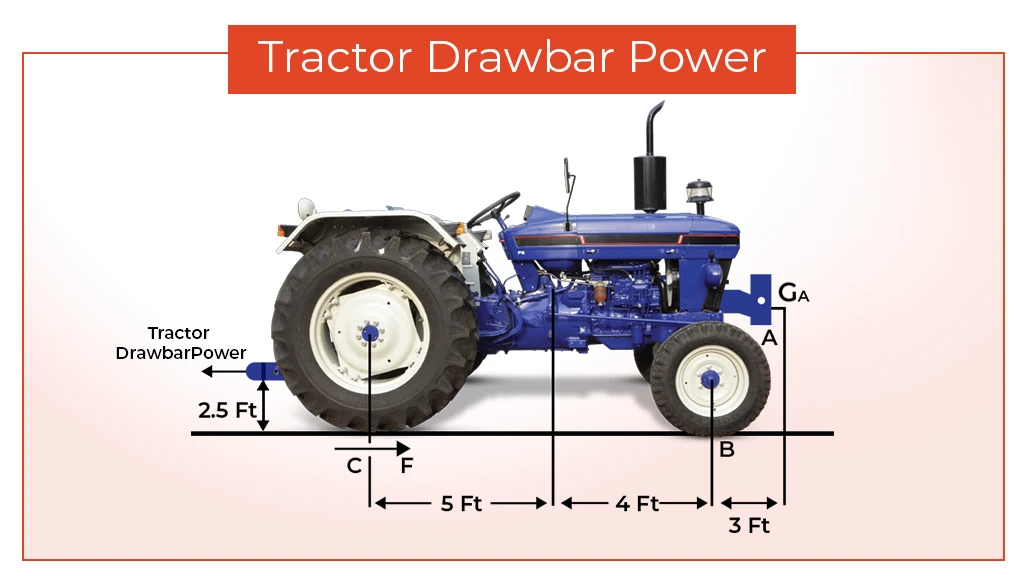
While operating a tractor implement, you might have come across terms like engine power, PTO power, and hydraulic power. When the tractor uses engine power to move the tractor and implements through the rear wheels or tracks it is called drawbar power.
Drawbar power is measured at the end of drawbar where an implement is attached to the tractor. This power is available for pulling loads at the draw bar.
PTO Horsepower
Power Take Off (PTO) in a tractor transmits the engine power to the farm implements that require rotational force to move. PTO is usually found at the rear of the tractor.
While transmission of power to the PTO some power is lost due to friction and the available power to operate the PTO implements is known as PTO power, which is expressed as PTO HP. It is usually 4 –5 HP less than the maximum engine power. It is possibly more important than the engine power as it helps operate implements like rotavator or power harrow.
Conclusion
Understanding the basics of tractor terminologies is essential if you are planning to buy a tractor. This will help you make a better decision and choose an appropriate tractor as per your farming needs. So, next time whenever you visit a tractor dealer do ask for the test report of that particular tractor where you can find all these terms.
Also, you can watch tractor videos on Tractokarvan to understand these concepts comprehensively.


Related Blogs

